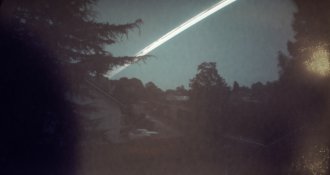Ned Hi! Have you done some of this kind of experiment? I know you are cooking all sorts.
I do it quite a lot... exposures anything from 2 hours to 2 years. Check out the "solargraphy" group on Ipernity or on Flickr... but it doesn't have to have sun streaks to get interesting results. John does it in a lensed camera and calls the result a "retina print".
Somewhere ( I'll have to dig around ) I made a picture of a Macbeth color chart, and one thing that is cool is that blues tend to invert to blue and greens tend to invert to green... so it's kind of a pseudo-color image. You can also get an effect like this if you make a paper negative ( I mean a short exposure, like a "normal" phtograph ) and develop it in super weak / cold developer... the tints on the paper negative will invert to different colors like they do with a solargraph.
The dark area might be where the paper got wet from condensation, and washed the image/made it whiter on the negative. That's a problem ( or feature, depending on your point of view ) with long exposures outside. Or it could be that something blocked the pinhole....
They will get darker with longer exposures, and they can be really pretty all by themselves, even without scanning/inverting.
It is difficult to fix these. I wrote about a way to
do it here, but I don't know if that will work with the paper you are using, and it will take some playing around to get the proportion of carbonate/bicarbonate just right.... but worth it if you decide to keep going. Basically, you "develop" the negative in a weak solution of sodium carbonate + sodium bicarbonate before fixing it in normal rapid fixer. It does change the color on the negative, but it makes the negative permanent.
Have fun!











